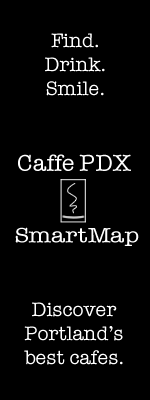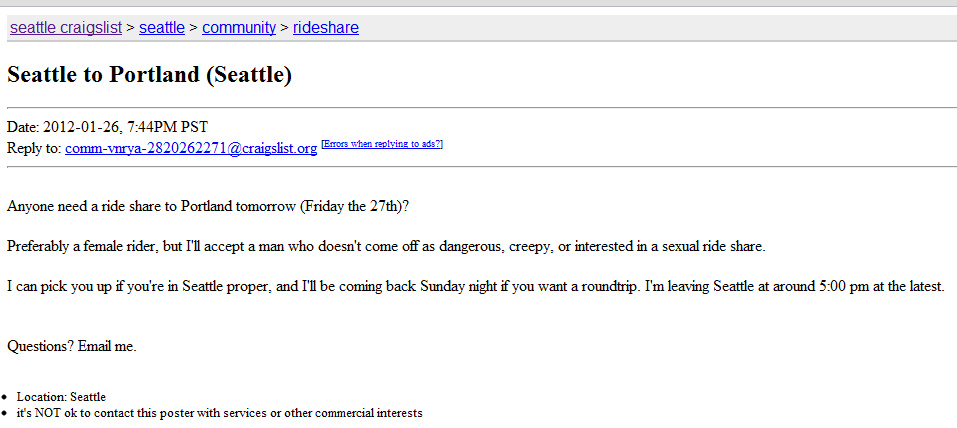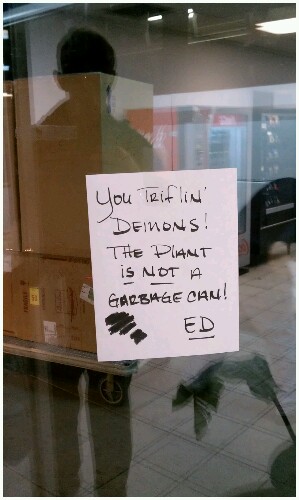Competitive coffee II - Judgment day
 Thursday, February 9, 2012 at 1:04PM
Thursday, February 9, 2012 at 1:04PM When I woke up Friday morning, the first thing that popped into my mind was the four elements of the espresso category along with the things I should be looking for in each one. I was focused. At least I hadn’t dreamed about cappuccinos.
We went to the convention center an hour before the start of the competition to do a little more calibration of our palates. We judged a few espressos and cappuccinos and returned to the judges’ chambers (really just a side room).
At 12pm, we got the call to come judge. We filed out into the competition hall, were introduced, shook the competitor’s hand and took our places. It was time to see if our training had prepared us.
Competition protocol
The protocol for SCAA-sponsored barista competitions is standard throughout the United States. During the competition, baristas have 15 minutes to prepare their competition station. The station is set up with a machine table (where the espresso machine sits), a preparation table (for storing milk and other ingredients) and the judges table (where the four sensory judges sit, and act as customers). As the barista prepare, they calibrate their grinder and carefully lay out the tools they will need to make the drinks. Usually, they set out plates, napkins, water glasses and spoons at the judges’ table.
After the 15 minute prep time, the judging team enters and takes its place. That’s when the main competition really begins.
Each barista must make three sets of four drinks during the 15 minutes – an espresso, a cappuccino and a signature beverage for each of the four sensory judges. That’s 12 drinks in 15 minutes! It would be a difficult challenge for a barista accomplish anytime and even more so with the pressure of competition weighing on them. Baristas must be efficient and fluid with their movements. The baristas are expected to talk about the coffee(s) they are using, describing the origin and the characteristics that make their chosen coffee special.
Seven judges evaluate each competitor’s performance. This includes two technical judges, a head judge and four sensory judges. The technical judges hover over and around the competitors while they are presenting, watching how the barista grinds, tamps, uses towels, keeps the station clean, and a myriad of other details.
The head judges watch the other judges to make sure they are judging consistently. The head judge tastes many of the drinks, often writing down their own scores. These scores do not count, but it does help the head judge estimate what the sensory judges should be scoring each drink. If there are any major discrepancy between the judges, the head judge helps resolve them.
I chose to be a sensory judge, for several reasons. First, I had done a lot of “sensory evaluation” (drinking espresso) over the last year and a half, so I knew I would feel more comfortable as a sensory judge. Second, technical judges have a large number of small things to watch and it helps to have a lot of barista experience. Most importantly, the sensory judges are the ones who get to taste the drinks. How could I go to a barista competition and not taste the drinks?
Put your tastes aside
As a sensory judge, one challenge was to put my biases aside and base my observations on the rules set by the competition committee. When I go cafés, I often “judge” the espresso and talk about its flavors. Most of my observations are highly subjective, which is fine in context of the blog. However, it doesn’t make for good competition scoring. To be a good judge, you have to be able to discard your own preferences and judge the espressos against the standards in the rule book. For espresso, this means you evaluate the crema, first for its color, then for its persistence and consistency.
Next, you mix the espresso three times from front to back, using the small spoon that the barista is required to provide. An espresso should have a balance of sweetness, sourness and bitterness, and these reside at different levels in the cup. Mixing the espresso allows you to detect all three flavors in each sip (assuming they are present). In addition to the taste balance, you also evaluate its “tactile balance,” or what coffee people often refer to as mouthfeel. These characteristics test the barista’s skills at pulling shots.
Cappuccinos are judged in a similar manner. The first criterion is visual appeal, which doesn’t mean the barista is skilled at latte art. Instead, judges are looking for contrast, sheen, balance, symmetry and whether or not there is a complete brown espresso ring around the outside of the milk in the center. Once the judges have evaluated the visual aspect, they take a spoon and push it across the foam of the cappuccino to check the persistence and consistency (“per-con,” in judging lexicon). Foam must be 1cm thick or more for the cappuccino to score Very Good in the per-con category.
After checking out how they look, the judges sip the cappuccino to determine its “taste balance.” Both sips must be taken in a location on the rim where the foam was not disturbed by the spoon. The judge should be able to detect a pleasant balance between the sweetness of the milk and the more bitter espresso flavors. The temperature should also be a temperature that you can drink the cappuccino immediately, without letting it cool.
The third category of drinks, the signature beverage category, has criteria that are less defined. The baristas get to express their creativity in making a drink, so some of the drinks are very complex. I have seen baristas add coffee reductions, gum syrup, star fruit juice, a raspberry ganache, an infusion of hops—you name it, and a barista has tried it.
It is somewhat harder to calibrate for the signature beverages because they are different from competitor to competitor, but no matter what, the drink should be designed to feature the espresso. One of the keys for baristas who want to score well in the “sig bev” category is to clearly explain what they are doing so that the judges know what to expect. They should also remember that the espresso is central to the drink – i.e., whenever they are thinking about how to compose the drink, they should think how all of the additions showcase the espresso. It is easy to forget that. The beverage can be delicious, but if the judge cannot taste a strong espresso presence, it will receive a low score.
During the calibration, the head judges and trainers drilled the procedure and evaluation criteria into our heads, constantly reminding us that we had to remove our own tastes and biases from the evaluation process as much as possible. They had us focus on describing what we saw, so that we could justify the scores that baristas would receive.
Speed is important when you are a sensory judge. You need to quickly evaluate the drinks, because any time lag negatively effects the quality of the beverages. The crema on the espresso is its thickest and most stable when it is first served. So is the foam on the cappuccino. A judge cannot hesitate. With an espresso, for example, the judges’ thought process is something like, “color, tip forward, tip back, stir, stir, stir, sip once, sip twice, give it a score.” Then you take a couple notes to support the score you give it. You have to do this in a few seconds. At first, you go slowly trying to remember everything, but the process becomes automatic over time.
After each competitor, we went back to the judges room to finish our score sheets. Our head judge gently pushed us to make any corrections necessary. His experience was super helpful as we struggled a couple times to come up with the justification for our scores. Instead of telling us to change our scores (both upward and downward, by the way), he had us justify the score we gave the competitors. If we had good justification for what we experienced, he let the score stand.
The trainers’ instructions rattled around my mind as I sat at the table, trying hard to concentrate on what the barista was saying. While we were finishing the score sheets, the head judges told us to be sure to make eye contact and smile with the competitors to make them feel more at ease. I thought we had been, but apparently we were all concentrating so hard on getting the judging right that we forgot to smile. It was easier to smile for the next two. We were all more relaxed by then.
Worth doing again
Each of the competitors put in a lot of work preparing, and I felt honored to be a part of the team that judged them. As they told us in the beginning of the training, one of the main roles of a judge is to support the baristas as professionals. We’re not there to “judge” them (okay, yes we are), but rather to give them feedback for all their preparation and make the competition as much fun as possible. Everyone wants to help raise the specialty coffee industry’s profile and these competitions are an opportunity to do that.
We (the judges) appreciated the hard work they put in as they prepared for the competition. My highest praise goes to our trainers, the head judges who got us ready for judging (and scared the hell out of us with those tests). Above all, I would like to thank Mike Strumpf, of Swiss Water, who was the head judge on my judging team on Friday. Mike did a fantastic job guiding us. His experience and expertise was obvious as he led us when we needed help making the proper scoring decisions.
Looking back, I had a great time judging, and plan to do it again sometime. Hopefully it will work out to judge at the USBC when it comes to Portland in April. See you there?
Epilogue
I left Tacoma for Portland on Friday (if you missed the story of that misadventure, it’s here), but I did watch parts of the next two days on my computer. If you look closely, you might see a couple of local PDX coffee people in the screen shots of the competition.
The finals took place on Sunday afternoon. The top six competitors from the previous two days presented their routines for the judges one more time. This year, the six finalists were all from Portland (I told you Portland was the center of the specialty coffee universe). Sam Purvis (the 2010 NWRBC champion), and Devin Chapman represented Coava, Laila Ghambari represented Stumptown, Collin Schneider competed for Sterling/Coffeehouse Northwest and Tyler Stevens and Marty Lopes came from Barista.
Devin Chapman finished first, Laila Ghambari, second, and Tyler Stevens, third. Chapman also won the regional Brewer’s Cup (for the second consecutive year), so he had a heck of a Sunday. He will automatically be entered in the semi-final round at the USBC, and the other five competitors can enter the first round of the USBC, if they choose. Portland is going to be well-represented as it competes on its home turf.




